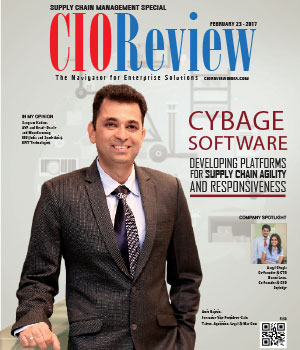
The Generics of Supply Chain Management
Suresh V. Menon, ERP Expert, Member - Research & Scientific Innovation Society(RSIS) | Thursday, 21 April 2016, 09:56 IST
 The primary goal of manufacturing process is to take inputs like –Manpower, Material, Machines, Measurements and Methods and produce products and by products as the output. To achieve this business must choose its manufacturing processes from the following: Project Manufacturing, Discrete Manufacturing, Repetitive Manufacturing, Flow Manufacturing and Process Manufacturing. It is not necessary that a company choose one type of process and stick with it. Companies typically have a mixture of one or more of these processes, depending on the products they produce and the market they serve.
The primary goal of manufacturing process is to take inputs like –Manpower, Material, Machines, Measurements and Methods and produce products and by products as the output. To achieve this business must choose its manufacturing processes from the following: Project Manufacturing, Discrete Manufacturing, Repetitive Manufacturing, Flow Manufacturing and Process Manufacturing. It is not necessary that a company choose one type of process and stick with it. Companies typically have a mixture of one or more of these processes, depending on the products they produce and the market they serve.
Discrete Manufacturing
You use Discrete Manufacturing for assemblies that you make in discrete batches for example this type of manufacturing is used in Automotive Companies
Repetitive Manufacturing
You use repetitive manufacturing when you produce assemblies on a continuous or semi -continuous basis over a predefined interval.You have production lines that can be used to produce either one assembly or many assemblies. In repetitive Manufacturing, you charge the cost of production, directly to the assembly and line.
Flow Manufacturing
You use flow manufacturing when you want establish a highly responsive manufacturing system. In this approach production is aligned with customer demand. You design flow production lines so that you can produce a family of assemblies at the appropriate rate and mix
Supply Chain Stocking Strategies The term Stocking Strategy denotes a process that identifies and maintains the optimum level of your bills of material at which you should maintain your inventory so that your inventory investment is minimum.
The following strategies are used in various industries:
Engineer-To-Order (ETO)
The product is engineered when the customer places the order, and the order typically carries the engineering specifications with it.
Make-To-Order (MTO)
Standard Product are designed and published in catalogues.The actual product is built on receipt of the customer order. An example of this would be machine building.
Assemble-To-Order (ATO)
These are also standard products and are often configured by customers.You don’t wait until an order is received to build an ATO Product.
Pick-To-Order (PTO)
Under this strategy a variety of shippable components are stocked. A computer System (Including the CPU, Monitor and printer) is an example of this.
Make-To-Stock (MTS)
In MTS environment, you produce your product and stock them in anticipation of customer orders. A good forecasting system is very important to this environment because most of the material and capacity planning is done using forecasts rather than actual demand. Examples include stereo systems and television sets.
A business move from ETO to MTS, the lead time available for the manufacturer decreases dramatically, so the manufacturer’s reliance on a good forecasting/Demand planning solution increases as the manufacturer moves down from ETO to MTS.
Production Planning and execution
Production Planning contains ideally the steps which are given in sequence below
- Sales and Operations Planning - Sales and Operation Planning provides a link between the sales forecasting and master Production Scheduling Process.
- Materials Forecasting - the forecasting algorithm calculates on weekly, monthly or fiscal accounting time periods, we will also be able to calculate a safety stock level based on the past statistical level, lead time and the customer service level percentage and it can also calculate the reorder point level.
- Demand Management - In this we are using to consolidate and refine the independent requirements for specific Materials.
- Master Production Schedule (MPS) - MPS Operates within only one level of Bill of Material whereas MRP operates through multiple level of Bill of Material i.e. Bill of Material is the Defining of the item and the raw materials which go into creating that item. In scheduling a achievable plan is derived that directs the actual manufacture of the firms products.
- Materials requirement Planning (MRP) - once you implement this Purchase requisitions are created for items that will be procured externally.
- Capacity Planning - is also known as the dispatch schedule.
- Long term execution
- Shop Floor Execution - Once the Order has been released to the shop floor in the factory the work begins to create a product through the addition of labour, machine processing and knowledge.
The Supply chain Management is a very vast process and it is beyond the scope of the title where I have given only a generic idea of the process which takes place in factories and workshops. We can use branded ERP’s to implement this process in factories after a consultation is done on the factory premises to document their existing process.
CIO Viewpoint
Role of IT in Enhancing Efficiency and...
By Sreenivas Pamidimukkala, Chief Information Officer, Mahindra Logistics
IT Overhaul in an Enterprise Transformation
By Parveen Aery, SVP & CIO, Ocwen Financial Solutions
Internet of Things: The Rise of Connected...
By Harnath Babu, Chief Information Officer, KPMG India
CXO Insights
Evolution of Supply Chain Management driven by...
By Shalabh Raizada, Chief Information Officer, Stellar Value Chain Solutions
Emerging Trends on Fruits & Vegetables Supply...










